Of Corryvrecken, Stramache and Tartan Drawers
Corryvrecken is the name of a famously fierce whirlpool off the coast of Jura, the island north of Islay in the Hebrides. George Orwell and his small son were lucky to escape it drenched, but with their lives. I submit that there’s another corryvrecken on Islay and her name is Rachel. She was my guide for my first two days on the island, having created for me a “wild and magical bespoke tour” – that being her inimitable brand. I was well into my email acquaintance with her last winter in Seattle before I recognized what bespoke meant. I thought she was organizing a tour to which I was improbably offering my input and others would be joining us.
But no, it was Rachel who was leaning against her white Volvo waiting only for me to disembark from the Caladonian-MacIntyre ferry from Kennacraig at Port Askaig, Islay, Scotland. By the time I got to Islay I knew I had gone somewhere far away. There was the nine hour plane from Seattle to London, five hour train from London to Glasgow, three hour bus from Glasgow to Kennacraig and two hour ferry to Port Askaig. Yes I could have flown the whole way but what’s the fun in that? I wanted to know where I was going. There was plenty of time to think about what the hell I was doing during the long, tiring journey .
The bus from Glasgow to Kennacraig could have been a ride through the evergreens of the Olympic Peninsula except the mountains are smoother and less rugged looking. We followed Loch Lomond for a while. I think I saw the “steep, steep side of Ben Lomond” but I couldn’t be sure as it didn’t look all that steep to me. Next to me a young woman was blowing out her ear drums through her ear buds so I put in my own and found Walter Berry singing “Mache diche, mein Herzen rein.” Winding through the Scottish lochs on a two lane road listening to the St Matthew Passion is an experience not to miss.
A woman got on at Crarae and announced to the entire bus, “I’m wet, I’m tired, I’m in a bad mood. I’m going into town for my drugs and booze and to do my yoga.” The bus laughed and I smiled but I also thought, oh god, that’s me all over again.
At the port of Kennacraig, there is just enough time to buy a ticket and walk the gangway onto the Finlaggan, a gleaming, elegant boat, more like a miniature Queen Mary than a ferry. I was all over it. I chatted for a long time with Peter over a bowl of soup. Peter goes around the world visiting bothies, remote cabins used by the most intrepid hikers, making sure they are still secure and safe. I stood outside in a breathtaking wind as the boat sailed alongside Jura. A white van moved along the island road and the woman next to me commented. “There’s rush hour on Jura.” I found the “quiet room” at the end of the ride and sank there into my jet-lagged thoughts until time to disembark and to meet Rachel.
Rachel is tall and exudes energy. Her voice and her eyes are full of mischief, humor and little nonsense. After two days with her, I decided she was the incarnation of a gude faerie in the Seelie court. (look it up). We drove down the island, talking easily. The afternoon ferries from Kennacraig go to Port Askaig at the top of the island. My destination was Port Ellen at the bottom and where the morning ferries come and go.
I stayed at The Grange, a big yellow guesthouse at the top of Mansefield Road. There I was entertained and looked after by Margaret and Harold Hastie. They gave me a large room with a view of the harbor and at night, the moon. Harold, who not incidentally also has the mischief in his eye, hoists a flag from the country of each of the guests. When Rachel pulled into the drive, an Australian and an American flag were flying high on a flagpole outside the guesthouse.
I was touched. I felt so welcome. Even so, I said I wasn’t sure I wanted anyone to know I was American. Fly the flag, by all means, but tell them I’m Canadian! Or at least know that I didn’t vote for Trump. Over and again people said they’d yet to meet an American who had!
A lovely antique piano so vintage that the Hasties can’t find anyone to tune it sits just inside the house where I saw it every time I entered and left the house. I played a piece of music entitled “Westering Home,” an old fashioned tune in three time written about Islay by the Scottish composer of the 1920s, Hugh Roberton. He also wrote the tune to “Mairi’s Wedding,” which my OK Chorale has sung and to “All in the April Evening,” whose ghastly text was popular in its day. Harold and the guests came to listen as I played. It has a sentimental magic and I felt its pull myself.
Westering home, and a song in the air,
Light in the eye and it’s goodbye to care.
Laughter o’ love, and a welcoming there,
Isle of my heart, my own one.
Tell me o’ lands o’ the Orient gay,
Speak o’ the riches and joys o’ Cathay;
Eh, but it’s grand to be wakin’ ilk day
To find yourself nearer to Islay.
Saturday morning I breakfasted with Ken and Derek, two brothers from Barrow–in-Furness in England although Derek now lives in Australia now which accounted for the Australian flag flying outside The Grange.
“Barrow-in-Furness,” I said. “That’s the home of the woman who wrote the war diaries for Mass Observation.”
Ken thought for a minute, “That’s right. Nella.”
It took both of us until the next day to remember Nella’s last name: Last. Ken said he quite liked his town being known for the “lady who wrote the war diaries.”
Rachel picked me up at 9:00 and for the next two days I felt repeatedly that Rachel and jet lag don’t mix. She radiates life and energy; I had to rally myself to keep up. We took off north toward Port Askaig, peeling off the main road to a narrow one in order to avoid Bowmore, the largest village on the island.
“We’ll take the high road,” she said.
“What’s the high road?” I asked, thinking I might get some geography surrounding the Loch Lomond song.
She looked at me as though she was afraid she had a nit-wit on her hands for the next two days. “It’s not the low road,” she said.
Oh.
At Port Askaig we drove onto a flat bed that turned out to be a small ferry like the Port Townsend-Whidbey Island ferry used to be. It pulled away and I got out of the car to enjoy what later was called the best day they had had all summer (a few said it was the summer): warm with a brilliant blue sky, sun and always wind. At the crossing’s end I walked onto the island of Jura.
Jura (pronounced like it’s spelled but you have to be able to make one quick roll of the r; by the way, Islay is pronounced “eye-la”) was my special request. George Orwell spent the last few years of his life on Jura, writing 1984. While I loathe that particular novel, I love just about everything else he wrote and have no end of admiration for him as a person. His old home, Barnhill, is still there but the main road stops before it gets there and a rugged vehicle is needed to go the final two hours of travel. The thing to do would be to go in with several days’ provision and stay. That’s my plan for next time.
We parked in the only village on the island, Craigshouse, and had lunch at the Jura Hotel where Rachel’s friend Maggie joined us. Maggie’s parents had been neighbors of Orwell up at Barnhill and I could barely keep myself from leaping on her when she sat down.
Her father had helped George dig his garden and they’d stop for a “tot of rum.” He was quiet. He was ill—he had TB. His sister, Avril, was there looking after him. Maggie apologized that she had so little to tell me. It was before she was born and before Orwell became famous.
“Oh, Maggie,” I said. “You’re four degrees of separation between me and George Orwell and I’m delighted to have met you!”
Maggie gave me one of her free drams. When you live on Jura, you get three wee drams a month in the Jura Hotel. A wee dram is somewhere before one and two fingers. I had a dram of Jura Scotch called Sevenoak.
Rachel and I visited the distillery just across the road, then carried on up the island over the Three Arch bridge where I could see all three Paps of Jura. Mostly you see just the two and they look suspiciously like breasts. I found out later that was the whole point. Pap is old Norse for breast-shaped hills. I can’t imagine anything in America being called a pap; the Republicans would throw a sheet over it.
At Knockrome we plundered an old telephone kiosk that had been turned into a wee book shop. Further up the road was a post box that had discontinued service for two years because a starling had taken up residence in it. When the bird died, a plaque commemorating Mrs. Starling’s residence was attached to the box.
Back in Craigshouse we visited an old photo gallery of island life in a tiny room off the church. It smelled of a century’s worth of damp. The black and white photos were group according to activity: farming, school, church. One old woman with a forbidding face was captioned The Stramache and I learned a new word. A stramache is an uproar, a row. Apparently this Stramache was a terror.
Rachel suggested I nonchalantly drop the line to Margaret and Harold that there had been a stramache on Jura and see if I could get them wound up. We practiced my nonchalance but I couldn’t quite pull it off on the Hasties. I tried it the next morning at breakfast. Harold got that gleam of mischief in his eye and looked as though he wasn’t quite sure whether or not to believe me
“Did they call out the coast guard?” Harold is in the coast guard so he’s seen a fair number of stramaches.
I grinned. “No, I was just trying out my new word.”
We came off Jura mid-afternoon and went to Finlaggan, the ancient seat of the Lord of the Isles. I tried to read some Scottish history before this trip and got hopelessly confused having very few reference points in the long history of the Celts and the Scottish tribes . The natives of the islands were the Celts who are best understood as a language group that included parts of Ireland and Scotland plus Wales, Cornwall, Brittany and even down into areas of Spain. The ancient seat in this case, would be a Celtic one. The word Lord is better understood as King as that is essentially who occupied the ancient seat.
Finlaggan is now a ruin on a small island. At the visitor’s center I met Catherine, the docent. I sussed right away that this was not a woman one asked stupid questions of. I’d be afraid she would demand why I hadn’t read the material.
We wanted to walk out to the ruin but the past week there had been so much rain that even the boardwalk was underwater, up to two feet in places. The efficient Catherine, however, had laid in a supply of wellies and people were sharing them. When they became free, Rachel and I set out down the path and waded out to the ruin. Rachel made me a gin and tonic out of Lussa Gin, which is distilled on Jura, and local tonic water that had quinine in it, which I don’t believe we can get any longer in our nanny state. We sat on the stones and talked as the wind played up the grass. The light and the wind felt magical and I thought, “the isle is full of noises.”
Finlaggan is a label that gets put on an affordable Scotch that I buy at Trader Joes. I learned from Rachel that all the distilleries take turns contributing to it. Over the years I have probably sampled Scotches from all eight distilleries; I just didn’t know it at the time.
Finlaggan marked the end of my first day on Islay. In the two days with Rachel, she would every so often go on a tear about Scotland, Gaelic, history, whisky, feminism. As an educator and business woman in whisky, she negotiates around entrenched male attitudes. I bet the men only mess with her once. She is passionate about her heritage. “Stop me if it’s too much,” she said. “My friends called me ‘Tartan Drawers.’” I went to bed early, the better to be ready for her in the morning.
 RSS Feed
RSS Feed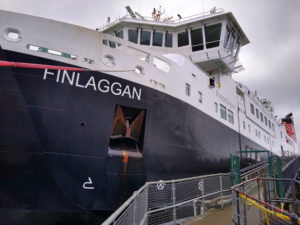
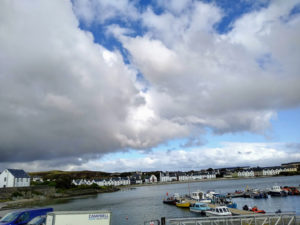
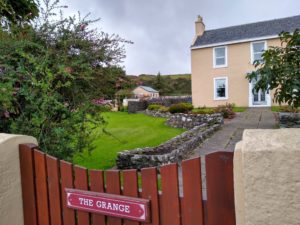
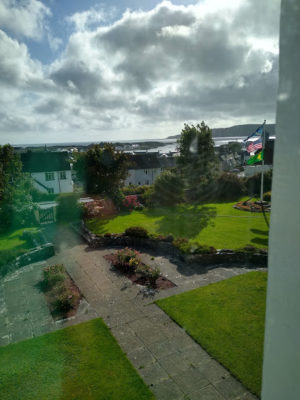
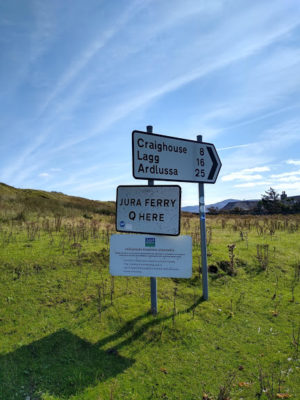
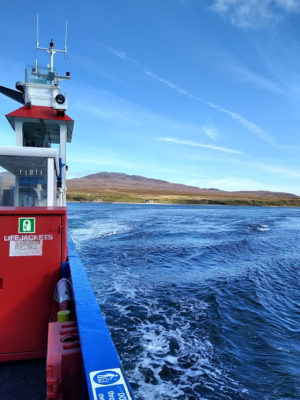
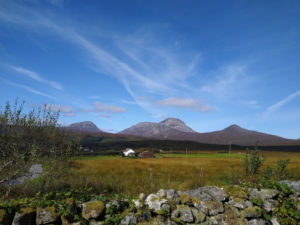
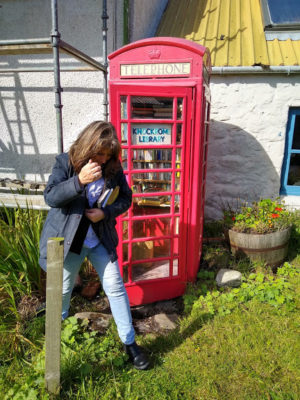
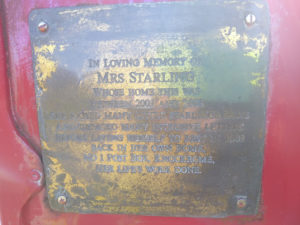
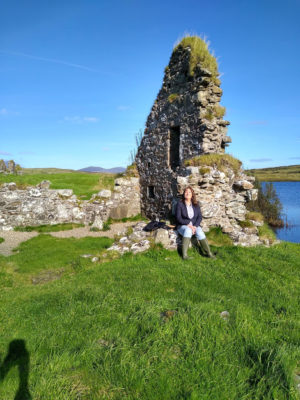
Did the Hasties appreciate your learning and playing a Scottish song?
It cracks me up thinking of you trying to nonchalantly mention something
that might rattle somebody!